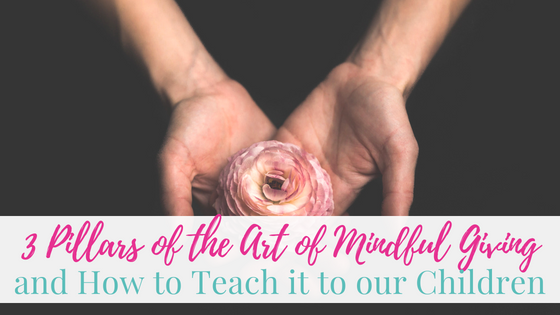The essence of mindfulness lies in the often forgotten ability to be present. While it sounds like a simple matter, practicing the art of presence can actually be much harder than it appears due to the simple fact that people of the 21st century have gotten used to perpetual neurosis of thought. However, it is crucial to keep trying, especially if you want to build a harmonious household. When the family boasts more than two partners, the best thing we can do is practice the art of mindful giving and learn how to teach it to our children.

1. It begins with you
The first pillar of any life-improving practice lies within. The epic struggle of good and evil happens primarily within one’s own heart, and the choices you make dictate the outcome of the battle. This means that, if you want to teach your kids something, you need to become good at it yourself. Remember, no matter how young, children are amazing at detecting the underlying hypocrisy of their parents’ actions. In fact, the sooner they detect it and the more they see across multiple dimensions of life, the closer you will be to the “fall from grace” in their eyes, and once that happens it will become inhumanly hard to bring back the trust.
When it comes to practicing mindfulness, you need to keep it simple and start off with something that is easy to manage. You are probably swamped with daily obligations, so 10-minute meditative sessions are a good way to “put you in the right frame of mind”. If you want to start teaching your children about the mindful practices, remember to do this in a place where they can see you, but don’t be too obvious. It is important to arouse interest, not to force anything on them. The first rule of mindful giving is that any gift, material or spiritual, has to be given in good graces.

2. A road to understanding
There is hardly a better way to teach something than to lead by example. One of the top benefits of mindfulness is that you will understand your family members better. Communication between parents and children is usually loaded with preconceptions and wrong assumptions. If many things are left unsaid, it can build to create a toxic dynamic that can mostly be boiled down to subjective perception. What is said does not necessarily mean what you hear. This is not a particularly surprising or rare phenomenon, but it does not mean that you shouldn’t work on it.
As you practice mindfulness, you take your ego out of the equation when you communicate. This means that you will take what your child says at face value and judge it as such. Over time, such practice can lead not only to better understanding, but to more constructive relationships. The non-skewed perception also helps to read between the lines of what is said, which means you will understand the wants and needs of your child better. This can lead to the easier discussions as well as some genuine and mindful gift ideas that will “seal” the good will between you and your child.
Material gifts aside, if your children feel if they have been heard, they will appreciate you more and they will be more willing to learn from your example. This gives you a perfect opportunity to introduce them to the concept of mindfulness and meditative practices that will turn them into calmer, well-balanced individuals.

3. Practice makes perfect
The final pillar comes in the shape of the most important gift you can bestow upon your child – diligence. By practicing mindfulness each day and proceeding to teach your child that it is not something one can learn overnight, you will teach them that diligence is a matter of patience and discipline. If your child starts to meditate in your company every day and follows the set schedule, they will learn, on a very good example, that life is not a race to the goal but a marathon without a destination. The pace has to be kept every day.
However, it is also very important to curb your expectations when it comes to your child and be candid about all the matters that come with their age. Teaching your children mindfulness might be a road of peaks and valleys, but the important thing is not to give in to their temper tantrums. Always keep a door open for them and find the best methods to practice presence along with them.
The constant chatter in our heads, as well as endless worrying about the past and the future, are not the hallmarks of the evolved mind. While some people might claim that these characteristics are exactly what puts us “above” other creatures of the earth, we might actually be wiser to learn something from them – the purity of presence. As you practice mindfulness, you will definitely become a better parent: you will constantly be on your toes and ready to give a swift and apt response to your child instead of succumbing to raw and visceral reactions. By teaching your child the same, you will arm them with some truly invaluable tools to tackle life.
About the Author

Isabel William
Guest Blogger
Isabel is a consultant by day and a blogger by night. She is a mom to twins 24/7 and from recently editor on Health & Mental Health on Ripped.me
Areas of interest are well being, mental health, self-improvement as well as the beauty of millennial transitions in all aspect of life, especially self-awareness.



Gosh isnt this post so true??? I don’t have kids, but there are some amazing and true facts in here…being present and mindful is EVERYTHING!!!!! This was an amazing post! Love your blog! xo
Thanks! Yes, totally agree with you that being present and mindful is everything.
I love this – all so key! I don’t have kids yet, but this is all really important to me.
These are so great, I believe that it starts young and with the parent … My daughter is a teen now and soo well behaved, I think its because I did things similar to these!
Yes, if we teach early on to be mindful, it will carry on into teenage years and adulthood.
I really love that you’re making it a priority to teach mindfulness to your children; their lives are certain to be much more enriched with it. I could certainly stand to learn something from these practices as well!
These are such great tips for mindfulness. I think a lot of what you said also applies to friendships and family relationships, but I can see how crucial this is with kids so they can be mindful adults!